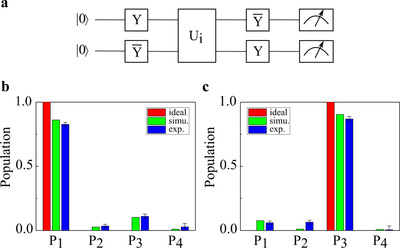A research team from CAS Key Laboratory of Microscale Magnetic Resonance led by ICQD member Prof. DU Jiangfeng at the University of Science and Technology of China (USTC) realized the first solid-state programmable quantum processor under room temperature. This study was published in Npj Quantum Information on January 25th, entitled A Programmable Two-qubit Solid-state Quantum Processor under Ambient Conditions.
Quantum computer, a promising technique that utilizes the superposition and entanglement of physical states, is expected to outperform its classical counterparts. For quantum computers to be practical, realizing programmable quantum computing is inevitable. In classical computing, users are able to complete a variety of computing tasks using the same hardware architecture. In most of the quantum computing experiments, however, their systems are only designed to run specific quantum algorithms, which means that implementation of new quantum algorithms would require reconfiguration of the hardware.
The concept of programmable quantum computing is proposed to solve this problem. Instead of altering the hardware, this method enables the quantum processor to perform any given tasks by simply reconfiguring relative parameters. In recent years, programmable quantum computation has been demonstrated using trapped ions, superconducting qubits and quantum-dot-based qubits. Nonetheless, considering the vulnerability of quantum coherence to noises, it remains to be a challenge to construct a solid-state programmable quantum processor under room temperature.
With the electronic spin and14N nuclear spin of nitrogen-vacancy (NV) center in diamond acting as a two-qubit system, researchers were able to form a programmable quantum processor that can perform quantum algorithms under room temperature. In this work, green laser pulses are applied to realize the initialization and readout of the quantum processor. Meanwhile, taking advantage of the universal quantum circuit designed in the study, the execution of a series of quantum algorithms can be transformed into the corresponding amplitudes and phases of microwave and radio frequency pulses. Up to this point, running a variety of quantum algorithms without tedious and expensive hardware reconfiguration are allowed through effective configuration of relative parameters.
In the course of quantum algorithm executing process, researchers incorporated the previous developed dynamic decoupling technology, effectively suppressing the adverse effects of noises in solids. Deutsch-Jozsa and Grover search algorithms were implemented on the programmable quantum processor with average success rates above 80%. In the future, a further increase of the quantum algorithm success rates is expected via improving the material (diamond) performance of the quantum processor (e.g. reducing the abundance of 13C isotope). This work demonstrates the flexibility of programmable quantum processors, taking an important step on the construction of a room-temperature solid-state quantum computing system.

Experimental demonstration of Grover search algorithm. (a) Quantum circuit of Grover search algorithm. (b-c) The results of Grover search algorithm. The red bars are the ideal case. The green bars are the simulated case considering the imperfect polarization and the decoherence. The blue bars are the experimental results. (Image by WU Yang)
This work was supported by the National Key R&D Program of China, CAS and Anhui province.
